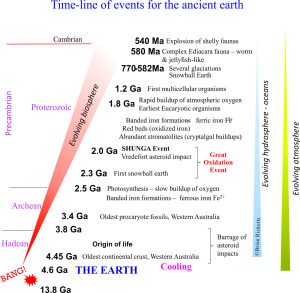A time-line for the first 4 billion years of Earth history
The Cambrian, that relatively brief period in geological history (40 odd million years) was witness to one of the most amazing series of biological events in the entire history of the Earth; the rapid, almost explosive appearance of marine critters with preservable shells and skeletons – a real first. Trilobites are probably the best known fossils from that period, but there are also some pretty weird and wonderful looking soft-bodied creatures (one famous fossil locality is the Burgess Shale near the town of Field, British Columbia). Most animal life today can track its origin to those early life forms. These events began about 540 million years ago (how easy these numbers roll off the tongue, or pen). But we also know that our Earth is pretty close to 4600 million years old (4.6 billion – How old is Earth); in other words there is almost 4 billion years, a humongous period of time in which, seemingly, not much happened. 4000 million years worth of boredom! This period is know as the “Pre” Cambrian, or Precambrian. Most Precambrian events did take place pretty slowly, but these events also determined the kind of world we now live in: the air we breath, the oceans and rivers, the biosphere and indeed life itself, all originated and evolved over this, the deepest of geological time.
A time-line of Precambrian events is shown in this fairly crude diagram. It is crude because the time scale is only approximately geometric – a linear scale would have left a lot of blank space.
The time-line begins with the origin of the universe, then jumps to 4.6 billion years, the approximate age of our earth; the intervening 9 billion year interregnum is conveniently ignored (but not forgotten). The remaining 4 billion years, condensed into this little box, lists those signal events that help us understand how the oceans and atmosphere evolved, from an early atmosphere utterly devoid of oxygen to one containing enough oxygen to support Cambrian and younger life forms. There are also Precambrian fossils, the oldest know being about 3.4 billion years old. From about 2.8 to 2.5 billion years and on primitive cyanobacteria (and probably viruses) constructed mats and reef-like structures of all shapes and sizes (known as stromatolites or cryptalgal structures), especially in shallow seas. In fact fossil slime became pretty common about 2 billions years ago; a time also referred to as the Great Oxidation Event. While not as spectacular as say modern coral reefs, they had one redeeming feature we can be thankful for – they photosynthesized oxygen.
Over the next few posts I will outline some of the scientific puzzles that have engaged scientists, especially earth scientists for decades: How old is Earth? How did the atmosphere evolve? How did the oceans evolve? What were the foundations of life, in what kind of environment did those primitive algae thrive, and what fossil evidence is there for the transition from slime to crawling, burrowing and swimming critters.
What does a million years feel like – Check out the post for Kids


















